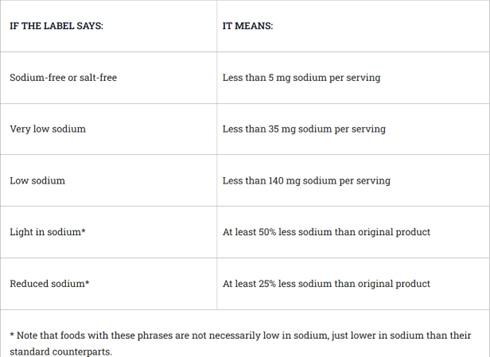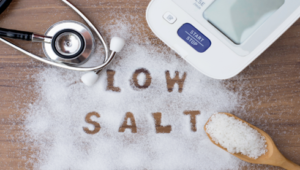Did you know that orange juice contains salt? Salt is a mineral made of sodium and chlorine; sodium is an important part of salt which plays many vital roles in the body. Sodium is a mineral which helps to regulate blood volume and pressure, provide the body with electrolytes, transmits nerve impulses, and helps to contract muscles fibres.
How excess sodium can harm our health:
When we eat a salty meal, our body responds by holding onto water to dilute the extra sodium, this increases the amount of fluid we hold within our blood vessels. High sodium levels can also damage the innermost layer of the blood vessels allowing fatty plaque to build up. High sodium levels can stimulate hormones which cause the blood vessels to tighten causing an increase in blood pressure, over time high blood pressure strains the heart causing the left ventricle to thicken in turn increasing the risk of developing heart failure later in life. The potential long-term consequences of a high sodium intake include damage to not just the heart but also the kidneys and brain.
Read food labels:
It has been shown that more than 70% of Australian’s average sodium intake comes from packaged, prepared and restaurant foods, that’s why it is important to check food labels. Every food product for sale in Australia is required to carry a food label that lists all the food’s ingredients and nutritional information. Look at the nutritional food section for the sodium content, making sure to check the serving size. Below is a table outlining what food label phrases mean in relation to sodium content:

How much salt do we need?
Most Australians eat more salt than their daily needs. Salt is roughly 40 percent sodium, that means that 1 gram of salt has 400milligrams of sodium. The recommended daily intake of salt for healthy Australians is 2000 milligrams (2 grams) of salt per day. The 2 grams per day is on the upper end of the limit and we should aim to consume less then this daily.
Good changes to make:
Cooking at home is a great place to start when reducing sodium intake, by cooking meals at home you can control how much salt is added. Fruits, vegetables and leans meats are healthy foods choices that usually contain very little salt. Lemon juice, garlic, herbs and spices are all great options to make food tasty with out adding extra salt to your diet.
Steps to consuming a low sodium diet:
By now we should know that eating a low sodium diet improves our overall health, but where do we begin to lower our intake? Below are some simple steps for you to start reducing sodium.
- Goodbye saltshaker: Adding extra salt to your food is not necessary as many foods already contain sodium. So put that saltshaker away!
- Eat more fresh foods: Swap those processed foods for fresh meats, vegetables, and fruits. These contain lower levels of natural sodium.
- Wash canned foods before consumption: When you buy canned foods, wash them before you eat them, doing this helps to reduce as much as 40% of sodium from the foods.
- Limit processed flavourings: Stay away from flavourings such as onion and garlic salts, soy sauce, BBQ sauce, pickles, and olives as these all have a high sodium content.
- Read food labels: Take notice of sodium levels in the foods you’re buying. Look at the label for the sodium content and try to find ones with lower sodium levels.
- Reduce convenience foods: Frozen meals, canned foods, gravy mixes, packet rice and pasta meals are all loaded with sodium – try to avoid these.
Conclusion:
Salt in our diet isn’t all doom and gloom, there are positive aspects that shouldn’t be overlooked. Salt provides essential minerals that act as electrolytes in the body which helps with fluid balance, nerve transmission and muscle function. It is important to read food labels to understand how much salt they contain, reading food labels is an easy change to make when looking to reduce salt in our diets. By reducing salt in our diets we are prolonging the life of our heart and its contraction ability.




